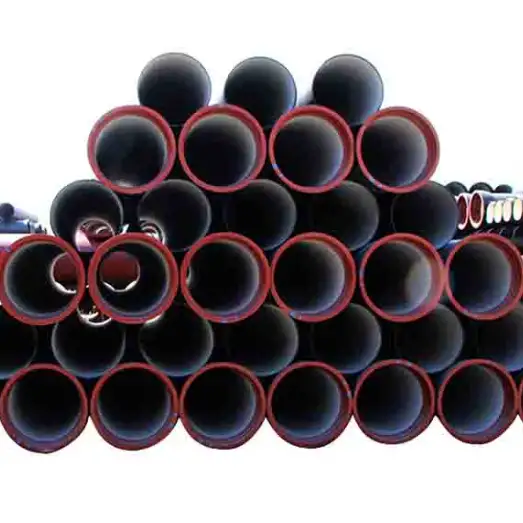The outside diameter (OD) of an 8-inch ductile iron pipe is 9.05 inches (229.9 mm) according to ANSI/AWWA C151 standards, ensuring seamless compatibility with fittings, valves, and joint systems in water and wastewater infrastructure. This standardized OD accommodates AWWA pressure classes (50/52/56) and varies slightly under ISO 2531 (228.3 mm for Class K9).

1. Introduction to Ductile Iron Pipes
Ductile iron pipes are a significant advancement over traditional cast iron pipes, offering enhanced strength, flexibility, and durability. These pipes are widely used in water distribution systems, sewage systems, and other infrastructure projects due to their reliability and performance.
2. Standard Dimensions of 8-Inch Ductile Iron Pipes
The 8-inch ductile iron pipe, commonly referred to as DN200 in metric units, has standardized dimensions to ensure compatibility with various fittings and joints. According to industry standards:
-
Outside Diameter (OD): 9.05 inches (229.87 mm)
-
Wall Thickness: Varies depending on the pressure class
-
Length: Typically available in 20-foot (6.096-meter) sections
These dimensions are standardized to facilitate uniformity and interoperability in piping systems.
3. Material Composition and Manufacturing Process
Ductile iron is produced by adding small amounts of magnesium to molten iron, which causes the graphite to form as spherical nodules. This process enhances the material’s ductility and strength. The manufacturing process involves:
-
Melting: High-quality scrap iron is melted in an induction furnace.
-
Alloying: Magnesium is added to the molten iron to achieve the desired chemical composition.
-
Casting: The molten metal is poured into molds to form the pipe shape.
-
Heat Treatment: The castings are heat-treated to achieve the desired mechanical properties.
-
Machining: Final dimensions are achieved through machining processes.
4. Mechanical Properties and Performance
Ductile iron pipes exhibit superior mechanical properties compared to traditional cast iron pipes:
-
Tensile Strength: Approximately 60,000 psi (414 MPa)
-
Yield Strength: Approximately 42,000 psi (290 MPa)
-
Elongation: Approximately 10-15%
-
Impact Resistance: High, due to the material’s ductility
These properties make ductile iron pipes suitable for applications subjected to dynamic loads and environmental stresses.
5. Corrosion Resistance and Longevity
Ductile iron pipes offer excellent resistance to corrosion, especially when coated or lined with protective materials. The internal surfaces are often lined with cement mortar or epoxy coatings to prevent corrosion and extend the pipe’s lifespan. With proper maintenance, ductile iron pipes can last over 100 years.
6. Applications in Various Industries
8-inch ductile iron pipes are utilized across various sectors:
-
Water Distribution: Transporting potable water in municipal systems.
-
Sewage Systems: Conveying wastewater in urban areas.
-
Industrial Applications: Used in chemical processing and other industrial operations.
-
Fire Protection Systems: Serving as part of fire suppression infrastructure.
7. Installation and Maintenance Practices
Proper installation and maintenance are crucial for ensuring the longevity of ductile iron pipes:
-
Installation: Ensure proper alignment and secure fastening to prevent leaks.
-
Maintenance: Regular inspection for signs of wear or corrosion; prompt replacement of damaged components.
8. Cost Analysis and Economic Implications
| Aspect | Ductile Iron Pipes | Traditional Materials |
|---|---|---|
| Material Cost | Higher | Lower |
| Installation Cost | Moderate | Higher |
| Maintenance Cost | Lower over time | Higher over time |
| Lifespan | Longer | Shorter |
While ductile iron pipes have a higher initial cost, their durability and lower maintenance requirements can result in cost savings over the long term.
9. Environmental Impact and Sustainability
Ductile iron pipes are recyclable, contributing to sustainability efforts in manufacturing. Their longer lifespan reduces the frequency of replacements, conserving resources and minimizing environmental impact.
10. Innovations and Future Trends
Advancements in coating technologies and materials science continue to improve the performance and longevity of ductile iron pipes. Innovations include:
-
Enhanced Coatings: Development of more durable and corrosion-resistant coatings.
-
Composite Materials: Integration of composite materials to reduce weight and enhance strength.
-
Smart Sensors: Incorporation of sensors for real-time monitoring of pipe conditions.
11. Frequently Asked Questions (FAQs)
1. What is the outer diameter of an 8-inch ductile iron pipe?
An 8-inch ductile iron pipe has a standardized outside diameter of 9.05 inches (229.87 mm), as per industry standards such as AWWA C151 and ISO 2531.
2. How does the wall thickness of an 8-inch ductile iron pipe vary?
The wall thickness of an 8-inch ductile iron pipe varies depending on the pressure class. For example, a Class 350 pipe may have a wall thickness of 0.41 inches (10.41 mm), while a Class 50 pipe may have a wall thickness of 0.25 inches (6.35 mm).
3. What is the typical length of an 8-inch ductile iron pipe?
The typical length of an 8-inch ductile iron pipe is 20 feet (6.096 meters), although other lengths may be available depending on the manufacturer and project requirements.
4. What are the advantages of using ductile iron pipes over traditional cast iron pipes?
Ductile iron pipes offer superior strength, flexibility, and resistance to corrosion compared to traditional cast iron pipes. These properties result in longer service life and reduced maintenance costs.
5. Can ductile iron pipes be used for both water and wastewater systems?
Yes, ductile iron pipes are suitable for both water and wastewater systems. They are commonly used in municipal water distribution networks and sewage systems due to their durability and performance.
6. Are there any environmental benefits to using ductile iron pipes?
Ductile iron pipes are recyclable and have a longer lifespan, reducing the frequency of replacements and conserving resources. Additionally, their durability reduces the need for repairs and replacements, minimizing environmental impact.
Conclusion
8-inch ductile iron pipes are a reliable and durable choice for various infrastructure projects. Their standardized dimensions, superior mechanical properties, and resistance to corrosion make them suitable for applications in water distribution, sewage systems, and industrial operations. Understanding their specifications and benefits can aid in making informed decisions for infrastructure projects.
